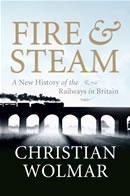 This new history of Britain¹s railways comes from the prolific pen of the nation¹s most passionate and well-known advocate of rail transport and travel. Christian Wolmar is an award-winning journalist who has made his name investigating the sad state of our urban and intercity railways with critical and incisive accounts such as Down the Tube (the London Underground) and On the Wrong Line (rail privatisation). And, as the Metronet contract for Tube maintenance and refurbishment collapsed in the summer of 2007, the former book¹s prediction that Gordon Brown¹s ³private/public partnership² scheme would be a disaster has proved to be depressingly accurate.
This new history of Britain¹s railways comes from the prolific pen of the nation¹s most passionate and well-known advocate of rail transport and travel. Christian Wolmar is an award-winning journalist who has made his name investigating the sad state of our urban and intercity railways with critical and incisive accounts such as Down the Tube (the London Underground) and On the Wrong Line (rail privatisation). And, as the Metronet contract for Tube maintenance and refurbishment collapsed in the summer of 2007, the former book¹s prediction that Gordon Brown¹s ³private/public partnership² scheme would be a disaster has proved to be depressingly accurate.
Wolmar¹s latest volume, Fire and Steam: A New History of the Railways in Britain, sees him turning away from polemical attack, at which he is so accomplished, towards more straightforward history. Wolmar¹s lively website claims that it is ³the first comprehensive general history of Britain¹s railways for over 30 years² and this may be true; but one might ask why we need a ³new² history of the railways when we already have magisterial works on the subject from scholars such as Jack Simmons, Michael Robbins, Philip Bagwell, and Terry Gourvish. The answer is that Wolmar¹s history promises to be more accessible to a lay readership than earlier academic treatments; it is a popular history, in the best sense of that term, rich in anecdotes without being anecdotal, firmly rooted and referenced in a broad knowledge of our railways (Wolmar is a self-confessed former trainspotter) yet still an entertaining read. In short it is the story rather than the history of British railways.
In some respects Wolmar¹s ³new² history is conventional in its approach. There is the familiar cast of characters from William Huskisson, the politician killed by the Rocket on the opening day of the world¹s first passenger railway, to unscrupulous Victorian railway barons (George Hudson) and larger-than-life entrepreneurs (Edward Watkin), to the heroines (Barbara Castle), villains (Ernest Marples) and unsentimental technocrats (Richard Beeching) of the 20th century. And there are the spectacular train crashes with their tales of malpractice, heroism and bad luck: the unfortunate track gang foreman John Benge whose oversight led to the terrible Staplehurst disaster of 1865 which Charles Dickens, travelling on the South Eastern Railway with ³his mistress and her mother², survived only because they happened to be seated in a carriage that stayed on the rails.
Yet even the most knowledgeable railway aficionado is bound to find something here which is new. For this reviewer it was the occasional gem twinkling amongst the more familiar details of the narrative: that trains only had lavatories from the 1870s how on earth did passengers hang on for the first 40 years of the railways? Or that the navvies who built Britain¹s early railways lived on beef and beer and wore ³moleskin trousers, velveteen square-tailed coats, gaudy handkerchiefs and white felt hats². Or the extraordinary fact that no British main line railway was actually built in the 20th century the sadly-doomed Great Central being completed in 1899 and the Channel Tunnel Rail Link in 2007.
If there is a criticism of this attractive and well-illustrated book it is that Wolmar seems to have missed an opportunity to more fully combine the entertaining scholarship of his narrative with the polemical bite of his earlier books. Only in the last five pages does he address the broad question of why it is that today¹s politicians and decision-makers have not learnt more from the 177 years of British railway history.
At the heart of most explanations for the grim fact that Britain, the birthplace of the railways, now has the poorest rail services in Europe, is what Wolmar describes as the ³fraught relationship between railways and government². After nearly two centuries we British have still to make up our minds as to whether we want the railways to be privately-owned, profit-making enterprises, or social services happily funded out of our taxes. Having tried every variation of public and private ownership since 1830, British railways are now reduced to what Wolmar aptly terms ³a strange limbo² between the two. Like the ³emasculated lion riding rather uncomfortably on a wheel² in British Railways¹ heraldic insignia, it is an awkward place to be for the nation¹s long-suffering rail passengers.
Peter Lyth lectures in transport history at the University of Nottingham and is a former editor of the Journal of Transport History.
